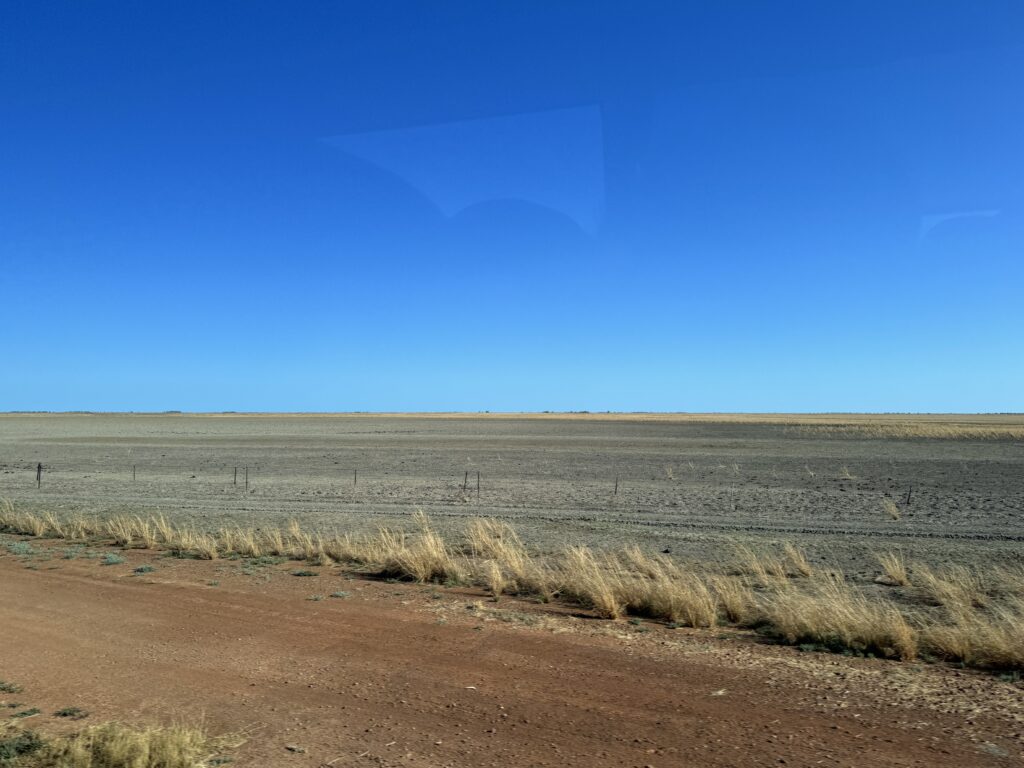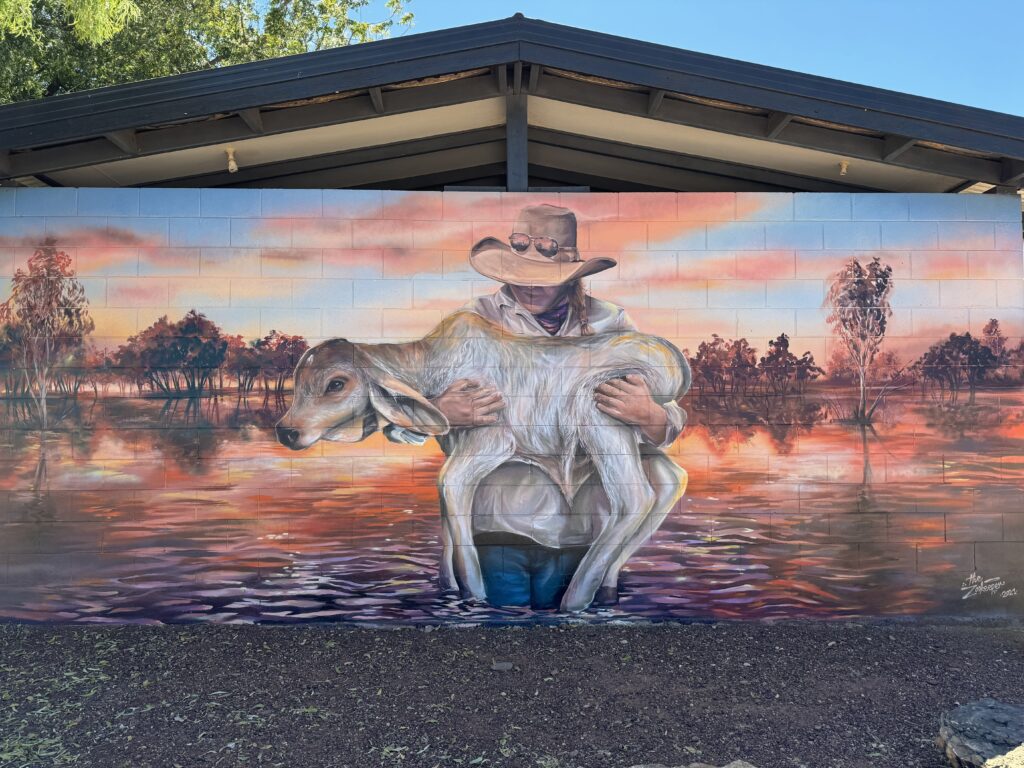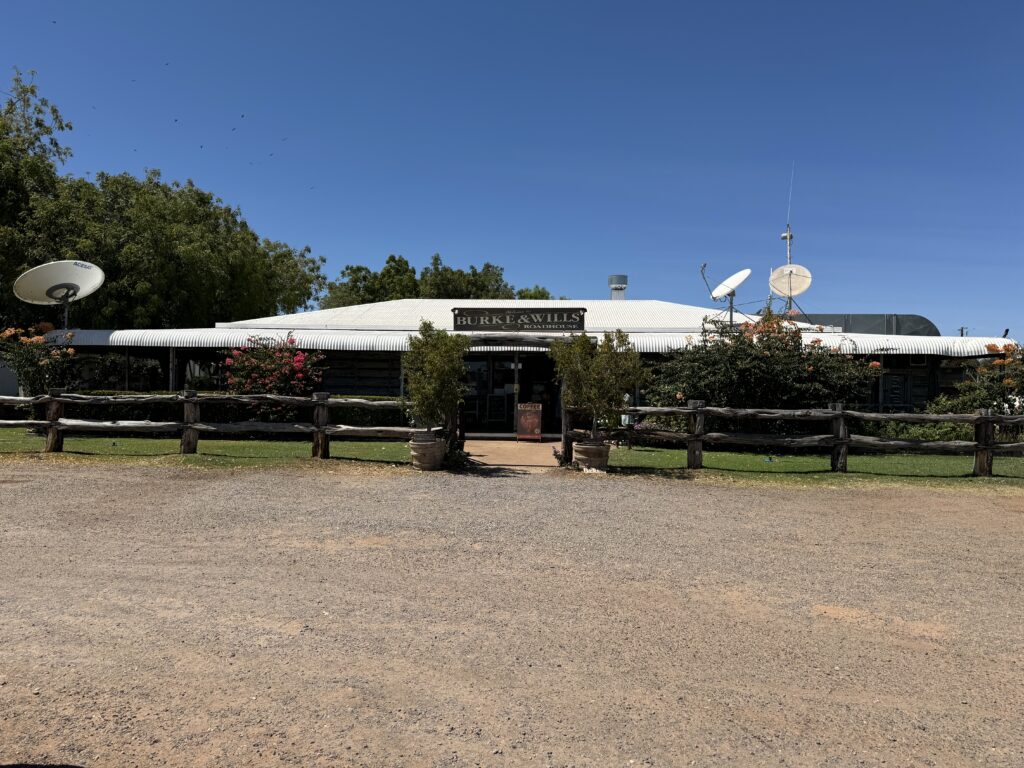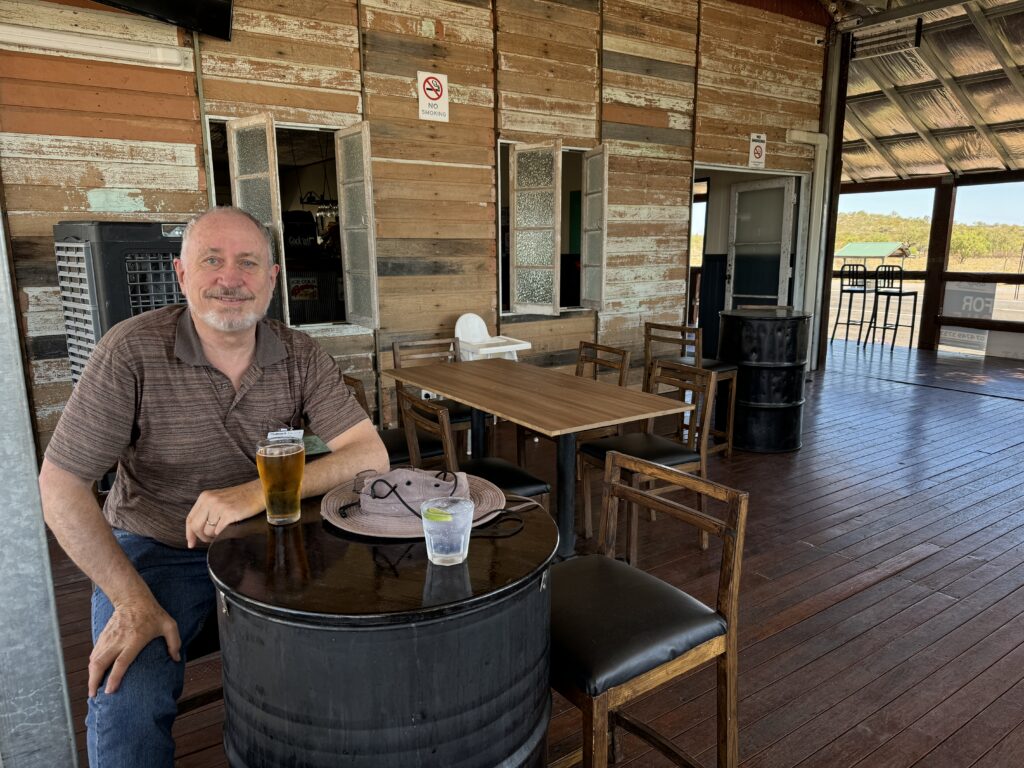Today, Sunday, as we left Karumba after a lovely 2-day stop – multi-day stops are precious, really – the tour leaders offered people masks as they got on the bus. Some of our travel companions feared we’d be offended but of course we wouldn’t be. We’d wear masks ourselves in the same situation. And, of course we were wearing masks in this situation.
I had a croaky voice which suggests I have COVID, but as we’d used our two test kits in Karumba, I am behaving as though I have it too – wearing masks, sanitising and social distancing. Whenever we sit down, we don’t join others but sit separately – letting others join us if they like. Some do, but most are uncomfortable, and that’s perfectly okay. We absolutely understand. It’s interesting, however, to see how different people respond. Anyhow, for dinner, we chose a table for two because it was indoors, which is a riskier environment.
This day was another driving day, with little points of interest but no big sightseeing plans. Outback Spirit, however, is good at finding interesting places to lift these driving days. I suspect the tour leaders, who travel through these places again and again play a role in identifying little treats.
Now, at last, the day … In these areas which have two seasons – the wet and the dry – there is a constant battle against the elements. Drought has its own problems but the ongoing impact of excessive rainfalls on roads, bridges, train lines, other infrastructure, and on farms, is massive. It’s often a fight against time to get things repaired, and up and running before the next wet hits. Our tour leaders, over the last few days, have pointed out where destruction has occurred and its impact on communities (not to mention on outback touring!) These tours have to be flexible – and so do their customers.
One example they told us about happened in the Flinders River region. In 2019, Cyclone Trevor caused a dry flood in the area, which involved a 70-kms wide flood flowing through the area. As our tour leaders said, stock died, which was horrendous and many of us Aussies saw it on news programs, but on the other hand, the fresh waters replenished the Gulf and tidal mangroves, which helped the prawning and barramundi industries. Wikipedia says that “due to the impact in Northern Queensland caused by the storm, the name Trevor was retired and will never be used again for an Australian region tropical cyclone. It will be replaced by Trung upon the next list repeat”.
We were amused by our tour leaders’ comment that several towns around the Gulf call themselves the Barramundi Capital, of which Karumba is just one!
As the day progressed, we left the Carpentaria Shire, which means leaving brolga and jabiru, and saltwater croc country. This made me a bit sad, as I wanted to see more of those birds. Anyhow, we moved into more treed areas which include grey box and silver-leaf box, before moving then into gidgee (stinking wattle) and mining country. (I loved geography at school, so I like hearing about the changes in the landscapes we are travelling through, and how they affect land-use in those regions.)
We also moved through what our tour leaders called black soil country. This soil has excellent water retention properties, which native trees and shrubs don’t like, so it creates naturally sparse country. That is, it hasn’t been cleared. (Made me think of the Monaro near us, which is also naturally sparse.)
Throughout the day we heard about many of the plants which grow in the areas we were passing through. One is the mimosa bush (a prickly acacia introduced by the cameleers). It’s becoming such a problem, that there are plans to reintroduce camels to control the spread of this plant. They are also testing poisoning these plants by drone. It’s fascinating hearing about the use to which new technologies – often created for particular purposes – are put.
Also during the trip, as we were driving through Burke and Wills country, the tour leaders played another Les Hiddins (Bush Tucker Man) program on the Burke and Wills expedition. It is one of the most tragic – by many definitions of the word – expeditions in Australia.
Today’s stops
For morning tea, we stopped at a park in Normanton, because it also provided a good toilet stop! This is important, particularly with people of a certain age.
Lunch was at the Burke and Wills Roadhouse, which looked to be in the middle of nowhere. It is! It’s address is Four Ways. Here we had a sandwich lunch provided by the roadhouse, in their covered outdoor area. It was a hot day – around 33°C by then – but what a difference a cover and some airflow can make.
Here we were told to check out the mural of a woman carrying a calf out of water. It referenced that situation I mentioned above re Cyclone Trevor. Here is what the mural’s plaque said:
While visiting Burke & Wills I had a number of conversations with people in the region and they explained their wish to focus on the. care that a farmer has for their animals.
During the floods many farmers were criticised for not having “done more’ to save their animals, a deeply traumatic criticism to hear and one far from the thoughtfulness and consideration that goes into raising animals.
This work touches on the nurturing aspect of cattle farming. depicting a farmer rescuing a poddy calf from the flood waters.
– Joel Fergie, 2020.
Then, unusually, we had a stop for an afternoon drink. It was at the quaint and quirky Quamby Pub. We won’t bore you with the story but suffice it to say that it is the result of one of those mad dreams people have, and is now for sale for AUD1.3million. Many of us chose their local drinks – a Quamby Beer or a Quamby Gin (and tonic). We sat on their outside covered verandah, which again was surprisingly cool, despite the heat.
Our evening meal was at the dining room of our motel in Cloncurry, the Gidgee Inn. Cloncurry is the point on this trip where I get into roads and places I knew in my childhood. It’s a bit exciting for me!








I’m glad you’re still able to enjoy the excursion and are continuing to share interesting observations about this part of your trip. The two weather pattern of droughts and floods and that traumatic cyclone in 2019 were eye openers for me who knows nothing of the area. The “every little thing” mural at the road house is poignant especially when hearing how the poor farmers were criticized for not taking good enough care of their animals. Len looks a bit isolated by himself on that empty veranda of the Quamby pub and I hope that toward the end of your trip, you can resume your interactions with the people on the tour.
Thanks Carolyn … I’m glad you are learning a bit more about different parts of Australia … like the USA as I know you know, it’s a huge and diverse place.
We are really hoping we test negative towards the end of the trip.
There are some lovely and interesting people I’d love to be talking to.
Great to see Lynn’s smiling face!! Carry on! Enjoying your sharing of your adventures as always!
Thanks Trudy